Every chapter available in the Samacheer Kalvi Class 11th Bio Botany Solutions subject is explained clearly in an easy way. Learn the depth concept by referring to the Samacheer Kalvi 11th Bio Botany Solutions Chapter 6 Cell: The Unit of Life Questions and Answers. Have a look at every topic and get the complete knowledge on the Bio Botany Solutions subject. You do not need to search for many materials for a better understanding of Bio Botany Solutions. Just refer to Tamilnadu State Board Solutions pdf and have a grip on the total subject.
Tamilnadu Samacheer Kalvi 11th Bio Botany Solutions Chapter 6 Cell: The Unit of Life
I believe that the best book is like a best friend to know the complete world by sitting in one place. When you have the best book you have many options to get great knowledge. Selecting the best book will lead to reaching your goal. Students who are looking for the best book to learn Bio Botany Solutions can use Samacheer Kalvi Class 11th Bio Botany Solutions Chapter 6 Cell: The Unit of Life Questions and Answers. Immediately start your learning with Samacheer Kalvi Class 11th Bio Botany Solutions Solutions Pdf.
Samacheer Kalvi 11th Bio Botany Cell: The Unit of Life Text Book Back Questions and Answers
I. Multiple Choice Questions
Choose the correct answer
Question 1.
The two subunits of ribosomes remain united at critical ion level of …………… .
(a) Magnesium
(b) Calcium
(c) Sodium
(d) Ferrous
Answer:
(a) Magnesium
Question 2.
Sequences of which of the following is used to know the phylogeny?
(a) mRNA
(b) rRNA
(c) tRNA
(d) Hn RNA
Answer:
(b) rRNA
Question 3.
Many cells function properly and divide mitotically even though they do not have …………… .
(a) Plasma membrane
(b) Cytoskeleton
(c) Mitochondria
(d) Plastids
Answer:
(d) Plastids
Question 4.
Keeping in view the fluid mosaic model for the structure of cell membrane, which one of the following statements is correct with respect to the movement of lipids and proteins from one lipid monolayer to the other…………… .
(a) Neither lipid nor proteins can flip – flop
(b) Both lipid and proteins can flip – flop
(c) While lipids can rarely flip – flop proteins cannot
(d) While proteins can flip – flop lipids cannot
Answer:
(c) While lipids can rarely flip – flop proteins cannot
Question 5.
Match the columns and identify the correct option:
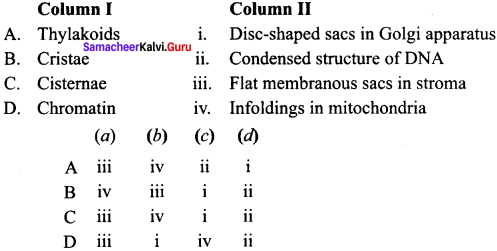
Answer:
(c) iii, iv, i, ii.
Question 6.
Bring out the significance of phase-contrast microscopy.
Answer:
- Light passes with different velocities after coming out of the thinnest and thickest areas of the phase plate thereby increases the contrast of the specimen.
- Direct light passes through a thin area of phase plate, where light passing from the specimen reaches the thick area of base plate
- Thick area light speed low, thin area, light travel fast therefore contrast is increased in the specimen
- Living cells tissues & cells cultured invitro during mitosis can be studied.
Question 7.
State the protoplasm theory.
Answer:
Protoplasm theory was proposed by Max Schultze which states that the protoplasm is the living content of cell and is a complex colloidal system.
Question 8.
Distinguish between prokaryotes and eukaryotes.
Answer:
Between prokaryotes and eukaryotes:
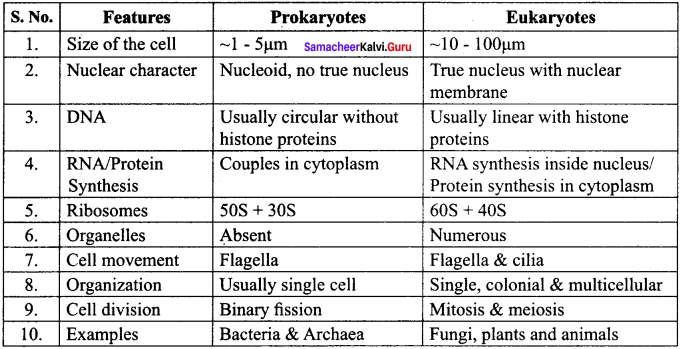
Question 9.
Difference between plant and animal ceil.
Answer:
| Plant Cell |
Animal Cell |
| 1. Usually they are larger than animal cells | 1. Usually smaller than plant cells |
| 2. Cell wall present in addition to plasma membrane and consists of middle lamellae, primary and secondary walls | 2. Cell wall absent |
| 3. Plasmodesmata present | 3. Plasmodesmata absent |
| 4. Chloroplast present | 4. Chloroplast absent |
| 5. Vacuole large and permanent | 5. Vacuole small and temporary |
| 6. Tonoplast present around vacuole | 6. Tonoplast absent |
| 7. Centrioles absent except motile cells of lower plants | 7. Centrioles present |
| 8. Nucleus present along the periphery of the cell | 8. Nucleus at the centre of the cell |
| 9. Lysosomes are rare | 9. Lysosomes present |
| 10. Synthesizes amino acids, coenzymes and vitamins required by them | 10. Cannot synthesize aminoacids, coenzymes and vitamins required by them |
| 11. Storage material is starch grains | 11. Storage material is a glycogen granules |
Question 10.
Draw the ultra structure of Plant Cell.
Answer:
The ultra structure of Plant Cell:
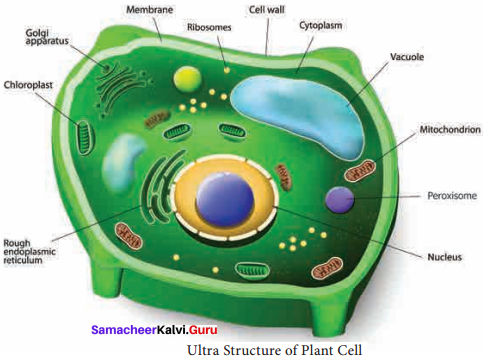
Samacheer Kalvi 11th Bio Botany Cell: The Unit of Life Additional Questions and Answers
I. Multiple Choice Questions
Choose the correct answer:
Question 1.
Micro graphia is a work of
a) Aristotle
b) Robert Miller
c) Robert brown
d) Robert Hooke
Answer:
d) Robert Hooke
Question 2.
Cell theory was modified by …………… .
(a) Schwann
(b) Schleiden
(c) Virchow
(d) Dutrochet
Answer:
(c) Virchow
Question 3.
Which of the following microscope produce 3D – image?
(a) Phase contrast
(b) TEM
(c) SEM
(d) Dark field
Answer:
(c) SEM
Question 4.
Who introduced the Electron microscope
a) Ernest Ruska
b) G. Binning & H. Roher
c) Rohith Mount
d) G. V. Stephenson
Answer:
a) Ernest Ruska
Question 5.
Medium for electron movement in TEM is …………… .
(a) Air
(b) Oil
(c) Water
(d) Vacuum
Answer:
(d) Vacuum
Question 6.
Resolving power of SEM is …………… .
(a) 5 – 10 Å
(b) 2 – 10 Å
(c) 5 – 20 nm
(d) 5 – 20 m
Answer:
(c) 5 – 20 nm
Question 7.
The membrane surrounding the Vacuole is known as
a) Mesoplast
b) Microplast
c) Tonoplast
d) Embryoplast
Answer:
c) Tonoplast
Question 8.
Scientist who named the cytoplasm as “Sarcode” is …………… .
(a) Dujardin
(b) Corti
(c) Purkinje
(d) Hugo Van Mohl
Answer:
(a) Dujardin
Question 9.
The pH of protoplasm is around …………… .
(a) 6.6
(b) 6.7
(c) 6.8
(d) 6.9
Answer:
(c) 6.8
Question 10.
The refractive index of protoplasm is …………… .
(a) 1.4
(b) 2.4
(c) 3.4
(d) 0.4
Answer:
(a) 1.4
Question 11.
The Suicidal bags of cells are
a) Polyribosome
b) Vacuole
c) Mitochondria
d) Lysosome
Answer:
d) Lysosome
Question 12.
Which of the following organelle is believed to be an endosymbiont?
(a) Ribosomes
(b) Mitochondrion
(c) Golgi bodies
(d) Nucleus
Answer:
(b) Mitochondrion
Question 13.
is the living content of the cell …………… .
(a) Cytoplasm
(b) Protoplasm
(c) Nucleoplasm
(d) Nucleus
Answer:
(b) Protoplasm
Question 14.
Cyanidin 3 Rutinoside is present in vacuoles of the petals of
a) Rose
b) Hibiscus
c) Antirhinum
d) Mirabilip
Answer:
c) Antirrhinum
Question 15.
…………… acts as a channel between the protoplasm of adjacent cells.
(a) Middle lamellae
(b) Pits
(c) Plasmodesmata
(d) Primary cell wall
Answer:
(c) Plasmodesmata
Question 16.
Fluid mosaic model was proposed by …………… .
(a) Schleiden and Schwann
(b) Singer and Nicolson
(c) Binning and Roher
(d) G. Palade
Answer:
(b) Singer and Nicolson
Question 17.
Which is the largest of the internal membranes?
(a) Golgi bodies
(b) Endoplasmic reticulum
(c) Tonoplast
(d) Nuclear membrane
Answer:
(b) Endoplasmic reticulum
Question 18.
Which of the following three has a single unit membrane.
a) Glyoxysome
b) Sphaerosome
c) Peroxisome
d) Centriole
(i) abc
(ii) bed
(iii) abd
(iv) acd
Answer:
(i) abc
Question 19.
organelle plays a major role in post translation process of protein …………… .
(a) Golgi bodies
(b) Nucleolus
(c) Ribosomes
(d) ER
Answer:
(a) Golgi bodies
Question 20.
Zymogen granules are synthesized in …………… .
(a) Lysosomes
(b) Golgi bodies
(c) Mitochondria
(d) Chloroplast
Answer:
(b) Golgi bodies
Question 21.
Altmann named mitochondrion as …………… .
(a) Apoplast
(b) Elaioplast
(c) Symplast
(d) Bioplast
Answer:
(d) Bioplast
Question 22.
………………………………. plays a key role in determining the shape of a mature cell.
a) Primary cell
b) Middle lamella
c) Secondary wall
d) Tertiary wall
Answer:
c) Secondary wall
Question 23.
Mitochondria are inherited from parent …………… .
(a) Male
(b) Female
(c) Both
(d) None
Answer:
(b) Female
Question 24.
F1 particles are also called as …………… .
(a) Polysomes
(b) Glyoxysomes
(c) Peroxisomes
(d) Oxysomes
Answer:
(d) Oxysomes
Question 25.
Primary cell membrane occurs only in
a) Chlorenchyma & Collenchyma
b) Parenchyma & Sclerenchyma
c) Xylemvessels & Tracheids
d) Parenchyma & Meristems
Answer:
d) Parenchyma & Meristems
Question 26.
The photosynthetic units are called…………… .
(a) Oxysomes
(b) Quantosomes
(c) Thylakoids
(d) Chloroplasts
Answer:
(b) Quantosomes
Question 27.
Which organelle is not membrane-bound?
(a) Mitochondrion
(b) Golgi bodies
(c) Chloroplast
(d) Ribosomes
Answer:
(d) Ribosomes
Question 28.
Ribosomes of mitochondrion are …………… .
(a) 16 S
(b) 80 S
(c) 70 S
(d) 50 S
Answer:
(c) 70 S
Question 29.
…………… mineral is required for structural cohesion of ribosomes.
(a) Ca2+
(b) H+
(c) Mg2+
(d) Cl–
Answer:
(c) Mg2+
Question 30.
Lysosomes originate from …………… .
(a) Mitochondrion
(b) Nucleus
(c) ER
(d) Golgi bodies
Answer:
(d) Golgi bodies
Question 31.
In mammals, peroxisomes are seen in …………… cells.
(a) Brain
(b) Lung
(c) Liver
(d) Heart
Answer:
(c) Liver
Question 32.
Which organelle has a single unit membrane?
(a) Ribosomes
(b) Glyoxysomes
(c) Polysomes
(d) Nucleus
Answer:
(b) Glyoxysomes
Question 33.
The single unit membrane of vacuoles is called as …………… .
(a) Tonoplast
(b) Symplast
(c) Apoplast
(d) Amyloplast
Answer:
(a) Tonoplast
Question 34.
Vacuoles of Apple cells store …………… .
(a) Sucrose
(b) Malic acid
(c) Citrate
(d) Flavanoid
Answer:
(b) Malic acid
Question 35.
Ribosomal biogenesis occur at …………… .
(a) Mitochondrion
(b) Polysomes
(c) Nucleolus
(d) Chromosomes
Answer:
(c) Nucleolus
Question 36.
The term chromosome was introduced by …………… .
(a) Bridges
(b) Strasburger
(c) Waldeyer
(d) Poster
Answer:
(c) Waldeyer
Question 37.
Stability to chromosome is offered by …………… .
(a) Satellite
(b) Telomere
(c) Kinetochore
(d) Nucleolus
Answer:
(b) Telomere
Question 38.
Life span of the cells is determined by …………… .
(a) Kinetochore
(b) Satellite
(c) Chromatin
(d) Telomere
Answer:
(d) Telomere
Question 39.
The metacentric chromosomes are …………… shaped.
(a) L
(b) V
(c) J
(d) I
Answer:
(b) V
Question 40.
Polytene chromosomes are observed in …………… of Drosophila.
(a) Endocrine gland
(b) Gall bladder
(c) Salivary gland
(d) Exocrine gland
Answer:
(c) Salivary gland
Question 41.
Lampbrush chromosomes occur at …………… stage of meiotic Prophase I.
(a) Leptotene
(b) Diplotene
(c) Zygotene
(d) Pachytene
Answer:
(b) Diplotene
Question 42.
Number of basal rings in gram positive bacteria …………… .
(a) 2
(b) 4
(c) 6
(d) 8
Answer:
(a) 2
Question 43.
Microtubules are made of …………… .
(a) Dyenin
(b) Tubin
(c) Tubulin
(d) Nexin
Answer:
(c) Tubulin
Question 44.
Cytoplasm is stained …………… by eosin.
(a) Pink
(b) Blue
(c) Greenish blue
(d) Green
Answer:
(a) Pink
Question 45.
Key difference between plant cell & animal cell is …………… .
(a) Ribosomes
(b) Vacuoles
(c) Cell wall
(d) Centrioles
Answer:
(c) Cell wall
II. Very Short Answer Type Questions (2 Marks)
Question 1.
What is meant by plasma decimate? what is its significance?
Answer:
It is a channel between the protoplasm of adjacent cells, through which many substances pass through.
Question 2.
Define the resolving power of a microscope.
Answer:
Resolving power or resolution refers to the ability of the lenses to show the details of object lying between two points. It is the finest detail available from an object. It can be calculated using the following formula.
⇒ Resolution = \(\frac {0.61λ}{NA}\),
where λ, = wavelength of the light and
NA is the numerical aperture.
Question 3.
Define magnification. How will you calculate it?
Answer:
The optical increase in the size of an image is called magnification. It is calculated by the following formula
![]()
Question 4.
List out the types of objective lenses used in Bright field microscope.
Answer:
The types of objective lenses used in Bright field microscope:
- 5x
- 10x
- 45x
- 100x
Question 5.
Name the 13 elements known as main or universal elements, present in the protoplasm.
Answer:
They are C,H,O, N, Cl, Ca, P, Na, K, S, Mg, I and Fe.
Out of this Carbon, Hydrogen, Oxygen and Nitrogen from 96% of protoplasm.
Question 6.
List out the components of Electron microscope.
Answer:
The components of the microscope are as follows:
- Electron Generating System
- Electron Condensor
- Specimen Objective
- Tube Lens
- Projector
Question 7.
Name the organisms that are exceptions to cell theory.
Answer:
Viruses, Virions and Prions.
Question 8.
Why do we call lysosomes suicidal bags of the cell?
Answer:
- They are spherical bodies enclosed by a single membrane
- They contain a variety of hydrolytic enzymes, that can digest materials within the cell
- The membrane is only protective in preventing the enzymes from digesting the very cell
- If damaged or contents released by the damage of membrane the enzymes in it digest the whole-cell so-known as Suicidal bags.
Question 9.
Define nucleoid.
Answer:
Nucleoid refers to the primitive nucleus which is not bound by a nuclear membrane and the DNA is without histone protein.
Question 10.
Name the organelles which are believed to be endosymbiont in the Eukaryote cell.
Answer:
Chloroplast and Mitochondrion.
Question 11.
Write a note on endosymbiont theory.
Answer:
Two eukaryotic organelles believed to be the descendants of the endosymbiotic prokaryotes. The ancestors of the eukaryotic cell engulfed a bacterium and the bacteria continued to function inside the host cell.
Question 12.
Point out any four prokaryotes.
Answer:
Four prokaryotes:
- Bacteria
- Blue-Green Algae
- Mycoplasma and
- Rickettsiae.
Question 13.
Why spirochaete is said to be a prokaryote?
Answer:
Spirochaetes is a prokaryote since its DNA lies in nucleoid and not bound by a nuclear membrane and also devoid of histone protein.
Question 14.
Name any two unique structures/organelles of a plant cell.
Answer:
Cell wall and Chloroplast.
Question 15.
What are the components of protoplasm?
Answer:
Protoplasm is composed of a mixture of small particles, such as ions, amino acids, monosaccharides, water, macro-molecules like nucleic acids, proteins, lipids and polysaccharides.
Question 16.
Write down the functions of the Golgi apparatus:
Answer:
- Production of – Glycoproteins, Glycolipids & Digestive enzyme
- Transportation of – Storage lipids
- Formation of – Lysosomes, cell plate and cell wall
- Secretion of – Carbohydrates(for formation of plant cell walls & insect cuticles)
- Proenzyme substance – Zymogen granules (enzyme precursors) are synthesized.
Question 17.
Which cell wall layer of plant cell is laid during maturation? Mention its role.
Answer:
Secondary wall is laid during maturation. It plays a key role in determining the shape of a cell.
Question 18.
How pits are formed?
Answer:
In plant cell, at few regions the secondary wall layer is laid unevenly, whereas the primary wall and middle lamellae are laid continuously such regions are called pits.
Question 19.
What is the role of plasmodesmata in a plant cell?
Answer:
Plasmodesmata act as a channel between the protoplasm of adjacent cells through which many substances pass through.
Question 20.
Name the two types of Pits.
Answer:
The two types of Pits:
- Simple pit and
- Bordered pit.
Question 21.
Define flip-flop movement.
Answer:
The movement of membrane lipids from one side of the membrane to the other side by vertical movement is called flip-flopping or flip-flop movement.
Question 22.
Name the two types of protein seen in the cell membrane.
Answer:
Two types of protein seen in cell membrane:
- Integral proteins and
- peripheral proteins.
Question 23.
What is meant by Svedberg unit?
Answer:
The size of Ribosomes & their subunits are usually given in the Svedberg unit a measure of particle size based on speed with which particle sediment in an ultracentrifuge – named after Theodor Svedberg.
Question 24.
Name any four endomembrane structures.
Answer:
Four endomembrane structures:
- Nuclear membrane
- endoplasmic reticulum
- vascular membrane
- golgi bodies.
Question 25.
What are dictyosomes?
Answer:
In plant cells, the golgi bodies are found as small vesicles which are called as dictyosomes.
Question 26.
What are porins?
Answer:
Porins are the proteins in the outer membrane of mitochondrion which forms the channel that allows the free diffusion of molecules smaller than about 1000 daltons.
Question 27.
What are oxysomes?
Answer:
The inner membrane of mitochondrion consists of stalked particles called elementary particles or Fernandez Moran particles. F1 particles or oxysomes.
Question 28.
How mitochondria helps in evolutionary studies?
Answer:
Mitochondrial DNA is used to track and date recent evolutionary time because it mutates 5 to 10 time faster than DNA in the nucleus.
Question 29.
Why mitochondrion is called a semi-autonomous organelle?
Answer:
Since mitochondria have their own DNA, it is called Organelle.
Question 30.
Why mitochondria are called “Powerhouses of cells?
Answer:
Mitochondria are called the Powerhouse of a cell, as they produce energy-rich (Adenosine Triphosphate) ATP.
Question 31.
Classify plastids based on colour.
Answer:
Chloroplast, Phaeoplast, and Rhodoplast.
Question 32.
Classify plastids based on storage & mention their storage component.
Answer:
|
Plastids |
Storage Content |
| 1. Amyloplast | 1. Starch |
| 2. Elaioplast | 2. Lipids / Oils |
| 3. Aleuroplast or Proteoplast | 3. Protein |
Question 33.
What are Quantosomes?
Answer:
Quantosomes are small, rounded photosynthetic units present in thylakoids.
Question 34.
List out the functions of the chloroplast.
Answer:
Photosynthesis, photorespiration.
Question 35.
What is the Svedberg unit?
Answer:
Svedberg unit is a measure of particle size depends on the speed with which particle sediment in the ultracentrifuge.
Question 36.
Where the biogenesis of ribosomes occur?
Answer:
Biogenesis of ribosomes are denova formation, auto replication, and nucleolar origin.
Question 37.
What are Polysomes? State its function.
Answer:
During protein synthesis, many ribosomes are attached to the single mRNA called polysomes or polyribosomes. The function of polysomes in the formation of several copies of a particular polypeptide during protein synthesis.
Question 38.
Define Autolysis.
Answer:
Autolysis is the process, where the lysosome causes self-destruction of cell on the insight of disease they destroy the cells.
Question 39.
List out the enzymes of lysosomes.
Answer:
Acid Hydrolases, Nuclease, Proteases, Glycosidases, Lipases, Phosphatases, Sulphatases and Phospholipidases.
Question 40.
Name any two organelles involved in photorespiration.
Answer:
Peroxisomes and Chloroplast.
Question 41.
Name few single unit membrane-bound organelles.
Answer:
Peroxisomes, Glyoxysomes and Sphaerosomes.
Question 42.
What are Tonoplasts?
Answer:
In-plant cells vacuoles are large, bounded by a single unit membrane called Tonoplast.
Question 43.
How vacuoles helps to maintain the structure of a plant cell?
Answer:
The major function of plant vacuole is to maintain water pressure known as turgor pressure, which maintains the plant structure.
Question 44.
What are metachromatic granules?
Answer:
Inorganic inclusions in bacteria are polyphosphate granules (volutin granules) and sulphur granules. These granules are also known as metachromatic granules.
Question 45.
Which is the largest organelle in a cell? State its function.
Answer:
Nucleus. It controls all cellular activities.
Question 46.
What is a pore complex?
Answer:
The pores are enclosed by circular structures called annuli. The pore and annuli form the pore complex.
Question 47.
What are the nucleolar organizers region?
Answer:
Secondary constrictions contain the genes for ribosomal RNA which induce the formation of nucleoli and are called nucleolar organizer regions.
Question 48.
Draw the types of chromosomes based on centromere position.
Answer:
The types of chromosomes based on centromere position:
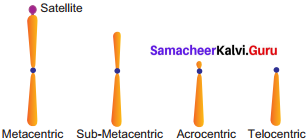
Question 49.
What is a telomere?
Answer:
A telomere is the terminal part of the chromosome. It offers stability to the chromosome. DNA of the telomere has a specific sequence of nucleotides.
Question 50.
Classify chromosomes based on function.
Answer:
Autosomes and sex chromosomes.
Question 51.
Name any two giant chromosomes.
Answer:
Polytene chromosomes and lampbrush chromosomes.
Question 52.
Define proton motive force.
Answer:
The proton motive force is the force derived from the electrical potential and the hydrogen ion gradient across the cytoplasmic membrane.
Question 53.
Name the basal rings found in flagella of gram-negative bacteria.
Answer:
The basal rings found in flagella of gram-negative bacteria:
- L – Lipopolysacchride ring
- P – Peptidoglycan ring
- S – Super membrane ring and
- M – membrane ring.
Question 54.
(a) Define histochemistry.
(b) What is Somatic pairing?
Answer:
(a) The technique of staining the cells and tissue is called histochemical staining or histochemistry.
(b) Maternal and paternal homologues remain associated side by side is called somatic pairing.
III. Short Answer Type Questions (3 Marks)
Question 1.
Explain the principle involved in Scanning Electron Microscope (SEM).
Answer:
In Scanning Electron Microscope (SEM) electrons are focused by means of lenses into a very fine point. The interaction of electrons with the specimen results in the release of different forms of radiation (such as auger electrons, secondary electrons, back scattered electrons) from the surface of the specimen. These radiations are then captured by an appropriate detector, amplified and then imaged on fluorescent screen.
Question 2.
Write a note on solation gelation property of protoplasm.
Answer:
The protoplasm exist either in semisolid (jelly – like) state called ‘gel’ due to suspended particles and various chemical bonds or may be liquid state called ‘sol’. The colloidal protoplasm which is in gel form can change into sol form by solation and the sol can change into gel by gelation. These gel – sol conditions of colloidal system are prime basis for mechanical behaviour of cytoplasm.
Question 3.
Explain the nuclear characters of Mesokaryotes.
Answer:
Mesokaryotes contains well organized nucleus with nuclear membrane and the DNA is organized into chromosomes but without histone protein components divides through amitosis similar with prokaryotes.
Question 4.
List out the unique characters of a Eukaryotic cell.
Answer:
Eukaryotes have true nucleus. The DNA is associated with protein bound histones forming the chromosomes. Membrane bound organelles are present.
Question 5.
Name the chemicals seen in the cell wall of plant cells.
Answer:
Cellulose, hemicellulose, pectin, lignin, cutin, suberin and silica.
Question 6.
Name the 3 distinct regions of plant cell wall.
Answer:
In plant, cell wall shows three distinct regions
- Primary wall
- Secondary wall and
- Middle lamellae.
Question 7.
Explain the role of hemicellulose, pectin & glycoprotein in primary cell wall.
Answer:
Hemicellulose binds the microfibrils with matrix and glycoproteins control the orientation of microfibrils while pectin serves as filling material of the matrix.
Question 8.
In cell membrane, phospholipids undergo flip-flop movement but not the protein. Why?
Answer:
The phospholipids can have flip-flop movement because the phospholipids have smaller polar regions, whereas the proteins cannot flip-flop because the polar region is extensive.
Question 9.
Define signal transduction.
Answer:
The process by which the cells receive information from outside and respond is called signal transduction.
Question 10.
Distinguish between rough endoplasmic reticulum and smooth endoplasmic reticulum.
Answer:
Between rough endoplasmic reticulum and smooth endoplasmic reticulum:
| RER |
SER |
| 1. Ribosomes are present in the outer surface of membrane | 1. Ribosomes are absent on the membrane |
| 2. It is involved in protein synthesis | 2. It is involved in lipid synthesis |
Question 11.
Write the major roles of Golgi bodies.
Answer:
Golgi complex plays a major role in post-translational modification of proteins and glycosidation of lipids.
Question 12.
Which is the most abundant protein on Earth? Where it is encoded?
Answer:
Rubisco is the abundant protein on Earth. It is encoded by the chloroplast DNA.
Question 13.
Classify ribosomes with an example.
Answer:
Types of Ribosomes
1. 70S Ribosomes (subunit 30S and 50S): 3 RNA molecule
- 16SrRNA in 30S subunit
- 23S and 5S in 50S large subunit
(Prokaryotic cells of Blue green algae, Bacteria, Mitochondria and Chloroplast of many Algae and higher plants)
2. 80S Ribosomes (subunits 40S and 60S): 4 RNA molecule
- 18Sr RNA in 40S small sub unit
- 28S, 5.8S and 5S in larger 60S subunit.
(Eukaryotic cells of plants and animals).
Question 14.
Write a note on Glyoxysomes.
Answer:
Glyoxysome is a single membrane-bound organelle. It is a subcellular organelle and contains enzymes of the glyoxylate pathway – oxidation of fatty acid occurs in glyoxysomes of germinating seeds.
Question 15.
What are cell inclusions? Give example.
Answer:
The cell inclusions are the non – living materials present in the cytoplasm. They are organic and inorganic compounds. Example: Phosphate granules.
Question 16.
Draw and label the structure of the Nucleus.
Answer:
The structure of the Nucleus:
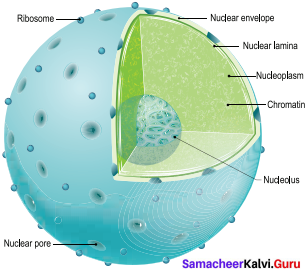
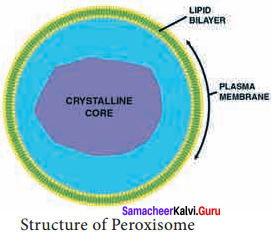
Question 17.
Distinguish between Euchromatin & Heterochromatin.
Answer:
The portion of Eukaryotic chromosome which is transcribed into mRNA contains active genes that are not tightly condensed during interphase is called Euchromatin. The portion of a Eukaryotic chromosome that is not transcribed into mRNA which remains condensed during interphase and stains intensely is called Heterochromatin.
Question 18.
Define Kinetochore.
Answer:
The centromere contains a complex system of protein fibres called kinetochore. Kinetochore is the region of chromosome which is attached to the spindle fibre during mitosis.
Question 19.
Write a note on SAT – chromosome.
Answer:
A satellite or SAT – chromosome are short chromosomal segment or rounded body separated from main chromosome by a relatively elongated secondary constriction. It is a morphological entity in certain chromosomes.
Question 20.
How telomeres helps in cancer studies?
Answer:
Maintenance of telomeres appears to be an important factor in determining the life span and reproductive capacity of cells so studies of telomeres and telomerase have the promise of providing new insights into conditions such as ageing and cancer.
Question 21.
Name the three types of centromere in eukaryotes.
Answer:
The three types of centromere in eukaryotes:
- Point centromere
- Regional centromere and
- Holocentromere.
Question 22.
What are giant chromosomes?
Answer:
These chromosomes are larger in size and are called giant chromosomes. In certain plants they are found in the suspensors of the embryo. The polytene chromosome and lamp brush chromosome occur in animals and are also called as giant chromosomes.
Question 23.
How polyteny condition is achieved?
Answer:
Polyteny is achieved by repeated replication of chromosomal DNA several times without nuclear division and the daughter chromatids aligned side by side and do not separate (endomitosis).
Question 24.
What is Microphotography?
Answer:
Images of structures observed through microscopes can be further magnified, projected and saved by attaching a camera to the microscope by a microscope coupler or eyepiece adaptor. Picture taken using a inbuilt camera in a microscope is called microphotography or microphotograph.
Question 25.
Draw the Structure of Peroxisomes.
Answer:
The Structure of Peroxisomes:

IV. Long Answer Type Questions (5 Marks)
Question 1.
Write a detailed account on Darkfield microscope.
Answer:
The dark field microscope was discovered by Z. Sigmondy (1905). Here the field will be dark but object will be glistening so the appearance will be bright. A special effect in an ordinary microscope is brought about by means of a special component called “Patch Stop Carrier”. It is fixed in metal ring of the condenser component.
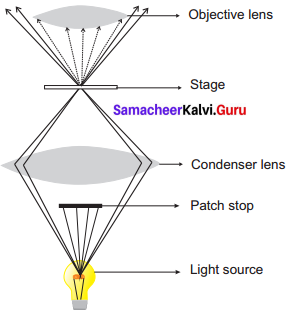
Patch stop is a small glass device which has a dark patch at centre of the disc leaving a small area along the margin through which the light passes. The light passing through the margin will travel oblique like a hollow cone and strikes the object in the periphery, therefore the specimen appears glistening in a dark background.
Question 2.
Compare Transmission Electron Microscope with Scanning Electron Microscope.
Answer:
Transmission Electron Microscope with Scanning Electron Microscope:
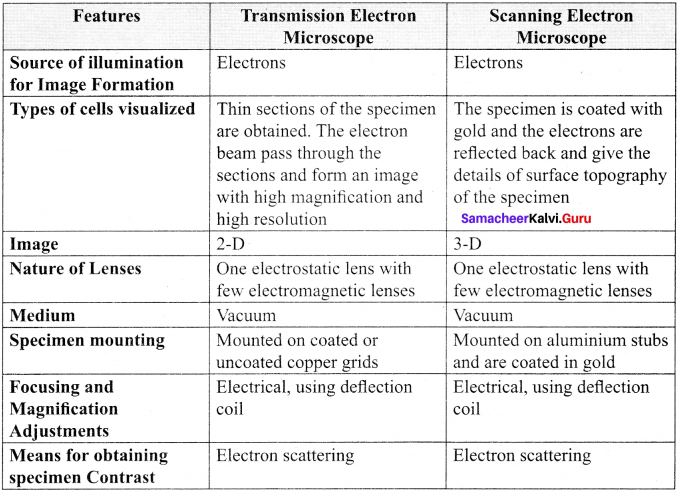
Question 3.
List out the features of Cell Doctrine.
Answer:
The features of cell doctrine are as follows:
- All organisms are made up of cells.
- New cells are produced from the pre-existing cells.
- Cell is a structural and functional unit of all living organisms.
- A cell contains hereditary information which is passed on from cell to cell during cell division.
- All the cells are basically the same in chemical composition and metabolic activities.
- The structure and function of cell is controlled by DNA.
- Sometimes the dead cells may remain functional as tracheids and vessels in plants and horny cells in animals.
Question 4.
Enumerate the properties of protoplasm.
Answer:
The properties of protoplasm:
- Protoplasm is translucent, odourless and polyphasic fluid.
- It is a crystal colloid solution which is a mixture of chemical substances forming crystalloid and colloidal solution.
- Protoplasm exhibits three Brownian movement, amoeboid movement and cytoplasmic streaming or cyclosis. Viscosity of protoplasm is 2 – 20 centipoises. The Refractive index of the protoplasm is 1.4.
- The pH of the protoplasm is around 6.8, contain 90% water (10% in dormant seeds).
- Approximately 34 elements are present in protoplasm but only 13 elements are main or universal elements i.e. C, H, O, N, Cl, Ca, P, Na, K, S, Mg, I and Fe. Carbon, Hydrogen, Oxygen and Nitrogen form the 96% of protoplasm.
- Protoplasm is neither a good nor a bad conductor of electricity.
- Cohesiveness: Particles or molecules of protoplasm are adhered with each other by forces, such as Van der Waal’s bonds, that hold long chains of molecules together. This property varies with the strength of these forces.
- Contractility: The contractility of protoplasm is important for the absorption and removal of water especially stomatal operations.
- Surface Tension: The proteins and lipids of the protoplasm have less surface tension, hence they are found at the surface forming the membrane. On the other hand the chemical substances (NaCl) have high surface tension, so they occur in deeper parts of the cell protoplasm.
Question 5.
Write down the functions of ER.
Answer:
- Mechanical support: It is associated with the cell membrane and nuclear membrane & gives mechanical support.
- Protein folding: Its chemical environment enable protein folding & necessary modification.
- Misfolded proteins degraded: Misfolded proteins if any are pulled out & degraded.
- RER(protein synthesis): Involved in protein synthesis.
- SER(detoxification): Contain enzymes that detoxify lipid-soluble drugs, certain chemicals & other harmful products.
- RER(protein synthesis): Involved in protein synthesis
- SER(detoxification): Contain enzymes that detoxify lipid-soluble drugs, certain chemicals & other harmful products.
Question 6.
Write down the functions of the Nucleus
Answer:
- Controlling all cellular activities.
- Storing the genetic information.
- Coding the information in the DNA – For the production of enzymes and proteins.
- DNA duplication & transcription occur.
- Ribosomal biogenesis occurred in the nucleolus.
Question 7.
Describe Endocytosis and Exocytosis.
Answer:
Cell surface membrane are able to transport individual molecules and ions. There are processes in which a cell can transport a large quantity of solids and liquids into cell endocytosis or out of cell exocytosis.
1. Endocytosis: During endocytosis the cell wraps the cell surface membrane around the material and brings it into cytoplasm inside a vesicle. There are two types of endocytosis:
- Phagocytosis – Particle is engulfed by membrane, which folds around it and forms a vesicle. The enzymes digest the material and products are absorbed by cytoplasm.
- Pinocytosis – Fluid droplets are engulfed by a membrane, which forms vesicles around them.
2. Exocytosis: Vesicles fuse with plasma membrane and eject contents. This passage of material out the cell is known as exocytosis. This material may be a secretion in the case of digestive enzymes, hormones or mucus.
Question 8.
Write down the significance of telomere.
Answer:
- It offers Stability to the chromosomes.
- DNA in telomere has Specific Nucleotide Sequences.
- Composed of many repeats of short DNA sequences & (5TTAGGG3′ in Neurospora crassa).
- It is important in determining the life span & reproductive capacity of cells.
- It shows light on study of aging & cancer.
- Telomere prevent fusion of chromosomal ends with one another.
Question 9.
Draw & describe the structure of a mitochondrion.
Answer:
Mitochondria are ovoid, rounded, rod shape and pleomorphic structures. Mitochondrion consists of double membrane, the outer and inner membrane. The outer membrane is smooth, highly permeable to small molecules and it contains proteins called Porins, which form channels that allows free diffusion of molecules smaller than about 1000 daltons and the inner membrane divides the mitochondrion into two compartments, outer chamber between two membranes and the inner chamber filled with matrix.
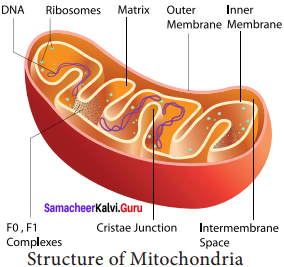
The inner membrane is convoluted (infoldings), called crista (plural: cristae). Cristae contain most of the enzymes for electron transport system. Inner chamber of the mitochondrion is filled with proteinaceous material called mitochondrial matrix. The inner membrane consists of stalked particles called elementary particles or Fernandez Moran particles. F1 particles or Oxysomes. Each particle consists of a base, stem and a round head. In the head ATP synthase is present for oxidative phosphorylation. Inner membrane is impermeable to most ions, small molecules and maintains the proton gradient that drives oxidative phosphorylation.
Question 10.
Draw & describe the structure of Nucleus.
Answer:
Nucleus is an important unit of cell which control all activities of the cell. Nucleus holds the hereditary information. It is the largest among all cell organelles. It may be spherical, cuboidal, ellipsoidal or discoidal. It is surrounded by a double membrane structure called nuclear envelope, which has the inner and outer membrane. The inner membrane is smooth without ribosomes and the outer membrane is rough by the presence of ribosomes and is continues with irregular and infrequent intervals with the endoplasmic reticulum.

The membrane is perforated by pores known as nuclear pores which allows materials such as mRNA, ribosomal units, proteins and other macromolecules to pass in and out of the nucleus. The pores enclosed by circular structures called annuli. The pore and annuli forms the pore complex. The space between two membranes is called perinuclear space. Nuclear space is filled with nucleoplasm, a gelatinous matrix has uncondensed chromatin network and conspicuous nucleoli. The chromatin network is the uncoiled, indistinct and remain thread like during the interphase. It has little amount of RNA and DNA bound to histone proteins in eukaryotic cells.
Question 11.
Explain the 3 mounting techniques
Answer:
- Whole-mount: The whole organism or smaller structure is mounted &observed.
- Squash: The Crushed or squashed material is observed.
Eg. Pollen grains, cell division in root tips & flower buds to observe chromosomes - Smear: Specimens is in the fluid (blood, microbial culture, etc) are scraped, or aspirated from the surface of the organ.
Eg. Epithetical cells.
Question 12.
List the functions of the Nucleus.
Answer:
Functions of the Nucleus:
- Controlling all the cellular activities
- Storing the genetic or hereditary information
- Coding the information in the DNA for the production of enzymes and proteins.
- DNA duplication and transcription takes place in the nucleus.
- In nucleolus ribosomal biogenesis takes place.
Question 13.
Explain the structure and movement of Eukaryotic flagella.
Answer:
Structure: Eukaryotic Flagella are enclosed by unit membrane and it arises from a basal body. Flagella is composed of outer nine pairs of microtubules with two microtubules in its centre (9 + 2 arrangement). Flagella are microtubule projections of the plasma membrane. Flagellum is longer than cilium (as long as 200 m). The structure of flagellum has an axoneme made up microtubules and protein tubulin.
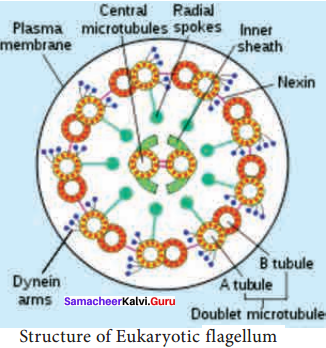
Movement: Outer microtubule doublet is associated with axonemal dynein which generates force for movement. The movement is ATP-driven. The interaction between tubulin and dynein is the mechanism for the contraction of cilia and flagella. Dynein molecules use energy from ATP to shift the adjacent microtubules. This movement bends the cilium or flagellum.
Question 14.
What is meant by microphotography or microphotograph?
Answer:
- Images of structures observed through microscopes can be further magnified, projected, and saved by attaching a camera to the microscope by a microscope coupler or eyepiece adaptor.
- Picture taken by an inbuilt camera in a microscope is microphotography or microphotograph.
Question 15.
Name any 5 common stains their colour & their affinity used in cytological studies.
Answer:
Common Stains used in Histochemistry

V. Higher Order Thinking Skills (HOTs)
Question 1.
What makes the plant cell more rigid than animal cells?
Answer:
Plants cells posses cell wall which provides sufficient rigidity and proper shape to them whereas in case of animal cells, cell wall is totally absent.
Question 2.
Cleaning organelle in the cell – Explain.
Answer:
Lysosomes contains a variety of hydrolytic enzymes, which can digest the materials within the cell. Thus lysosomes act as cleaning organelle of the cell.
Question 3.
Ribosomes are single membrane organelles present in both prokaryotes & eukaryotes. List out the sites where ribosomes are present in plant cell.
Answer:
The sites where ribosomes are present in plant cell:
- Cytoplasm
- On rough endoplasmic reticulum
- Inside mitochondira & chloroplast.
Question 4.
What does ‘S’ refer in a 70 S and an 80 S ribosomes?
Answer:
‘S’ refers to Svedberg units named after Theoder Svedberg. The size of ribosome and their subunits are represented by Svedberg unit.
Question 5.
Briefly give the contributions of the following scientists in the field of cytology.
(a) Schleiden and Schwann
(b) Singer and Nicolson
Answer:
(a) Schleiden and Schwann proposed the cell theory.
(b) Singer & Nicolson proposed the fluid mosaic model of plasmomembrane.
Question 6.
Is extra genomic DNA is present in prokaryotes & Eukaryotes? If yes, locate them in both the types of organisms.
Answer:
Locate them in both the types of organisms:
- In prokaryotes like bacteria, plasmids are the extra genomic DNA present in cytoplasm.
- In Eukaryotes, the circular DNA present in matrix of mitochondria & chloroplast are extragenomic DNA.
Question 7.
Give possible reasons to call mitochondria & chloroplast semi-autonomous organelles.
Answer:
Mitochondria & chloroplasts are considered semi-autonomous organelle due to the following facts.
- Both mitochondria & chloroplasts have their own DNA, which can replicate independently.
- They have their own ribosomes by which they self-synthesize same of their proteins without depending on cellular DNA.
Hope all the information given regarding Class 11th Tamilnadu State Board Bio Botany Solutions will help you to get good knowledge. For any queries, you can contact us and clear your doubts. Connect with us using the comment section. Also, we love your feedback and review. Get your Chapter Wise Samacheer Kalvi Class 11th Textbook Solutions for Bio Botany Solutions Chapter 6 Cell: The Unit of Life Questions and Answers PDF start learning for the exam.